Edinburgh, Scotland
December 9, 2010
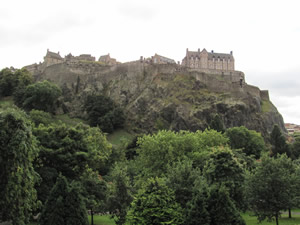 The Scottish capital of Edinburgh was everything I dreamed it would be and more. Rainy and overcast skies set the stage beautifully, casting the romantic, melancholy city in its best light, or lack there of. Solemn gray buildings stacked on top of each other dominated the old town, while lovely, but uniform Georgian townhouses stood proudly side-by-side in new town. The city’s dour exterior and stately classical architecture sheltered well the warm, beating heart of this vibrant center of Scottish history and culture. The Scottish capital of Edinburgh was everything I dreamed it would be and more. Rainy and overcast skies set the stage beautifully, casting the romantic, melancholy city in its best light, or lack there of. Solemn gray buildings stacked on top of each other dominated the old town, while lovely, but uniform Georgian townhouses stood proudly side-by-side in new town. The city’s dour exterior and stately classical architecture sheltered well the warm, beating heart of this vibrant center of Scottish history and culture.
Our hotel was located just off the main tourist street in old town, the Royal Mile, which stretches from the brooding Edinburgh castle on its craggy hill down to the stately Palace of Holyroodhouse, the royal residence of the Queen when she is in Scotland. Upon our arrival, we set out uphill towards the castle, enjoying the numerous statues, sites, and museums located on the Royal Mile.
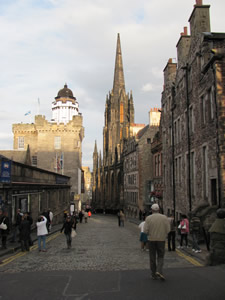 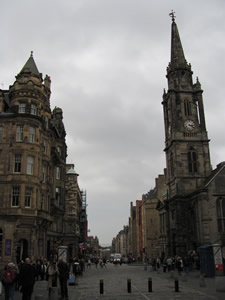
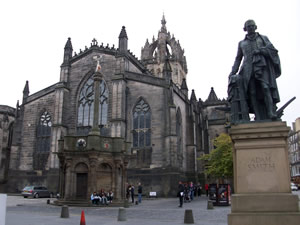 I especially enjoyed viewing St Giles Cathedral, Scotland’s most important church. Its ornate spire—the Scottish crown steeple from 1495—is a proud part of Edinburgh’s skyline. The interior houses a magnificently beautiful ceiling, as well as the Thistle Chapel, sacred sanctuary of Scotland’s highest chivalry order, the Order of the Thistle. The Mercat Cross stands on the downhill side of St Giles. A chunky pedestal that holds a slender column topped with a white unicorn, royal proclamations have been read at the Mercat Cross since the 14th century. Public hangings and other executions also took place for centuries at this spot. I especially enjoyed viewing St Giles Cathedral, Scotland’s most important church. Its ornate spire—the Scottish crown steeple from 1495—is a proud part of Edinburgh’s skyline. The interior houses a magnificently beautiful ceiling, as well as the Thistle Chapel, sacred sanctuary of Scotland’s highest chivalry order, the Order of the Thistle. The Mercat Cross stands on the downhill side of St Giles. A chunky pedestal that holds a slender column topped with a white unicorn, royal proclamations have been read at the Mercat Cross since the 14th century. Public hangings and other executions also took place for centuries at this spot.
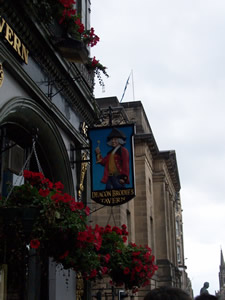
Another interesting building standing at the corner of Bank Street is Deacon Brodie’s Tavern. Deacon Brodie was the real life inspiration for the story “Doctor Jekyll and Mister Hyde,” and his fascinating story is told by a painting on the exterior wall, as well as the hanging signposts, which showcase his spooky split personality on opposing sides.
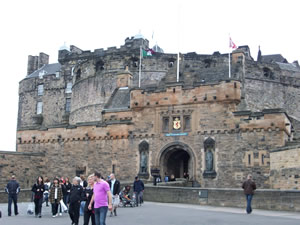
The approach to Edinburgh Castle is imposing, and as one imagines it has appeared for centuries. Just beyond the esplanade lies the tall gates, where statues of Robert the Bruce and William Wallace guard the entrance. The castle is the fortified birthplace of the city 1,300 years ago, and stands as an imposing symbol of Edinburgh proudly on a rock high above the rest of the city. While the castle has been both a fort and a royal residence since the 11th century, most of the buildings today are from its most recent use as a military garrison. The views over the city are particularly impressive and picture worthy, especially in the soft light of early evening. I particularly enjoyed viewing St Margaret’s Chapel, the cemetery for soldiers’ dogs located on a rocky outcrop below the infamous canon Mons Meg, and the Scottish crown jewels.
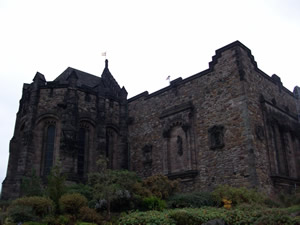 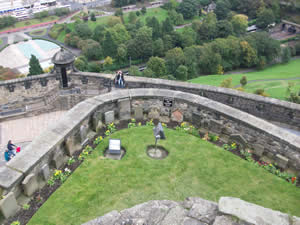
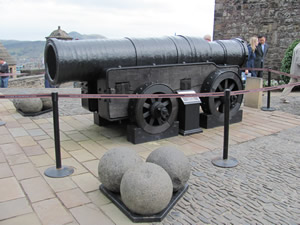 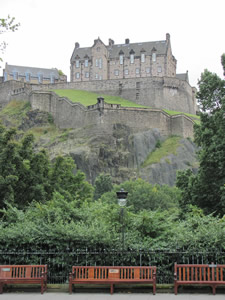
On our first evening in Edinburgh we joined the “Murder and Mystery” tour conducted by Witchery Tours and thoroughly enjoyed learning about the city’s infamous past and jumping in fright.
We woke to rainy skies the next morning and decided to visit some museums to dodge the showers. We dropped into Gladstone’s Land, which is laid out as a typical 16th to 17th century merchant’s house. “Land” means tenement, and these multi-story buildings—where merchants ran their shops on the ground floor and lived upstairs—were typical of the time. Gladstone’s Land comes complete with an almost-lived-in furnished interior and informative guides in each room who love to talk. One lady shared with us the reason stairwells always wind to the right, so that intruders’ right hands are encumbered by the stone pillar at the center, while defenders’ coming from the top always have plenty of room to swing their weapons. The only exception occurs at the castles of the clan Kerr, who were notorious for being left-handed. Other defensive methods against intruders included varying the stairs heights so that villains would trip in the dark, and low doorways so that people had to stoop when they entered a room, a thus were at a disadvantage in attacking.
We next passed through Lady Stair’s Close to the courtyard beyond in order to visit the Writer’s Museum at Lady Stair’s House. This aristocrat’s house, built in 1622, is filled with well-described manuscripts and knickknacks of Scotland’s three greatest literary figures: Robert Burns, Sir Walter Scott, and Robert Louis Stevenson. Edinburgh’s high society would gather in homes like this in the 1780s to hear the great poet Robby Burns read his work.
We then headed south to the Surgeon’s Hall Museum, of particular interest to me because of the current series of books I am writing. Edinburgh was a renowned medical city in the 18th and 19th centuries, hosting arguably the best surgeon’s college in the world. The Surgeon’s Hall Museum examines this history and displays such interesting items as a book jacket made from the skin of the infamous murderer and body-snatcher Burke.
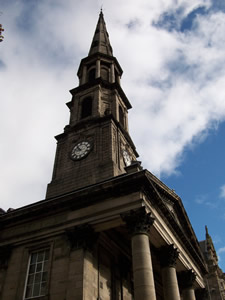 On our last day in Edinburgh, we strolled the stately squares of Georgian New Town. The entire elegantly planned New Town—laid out when George III was king—celebrates the hard-to-sell notion that Scotland was an integral part of the UK. The streets and squares are named after the British royalty. Even Thistle and Rose Streets are emblems of the two happily paired nations. St Andrew’s and St George’s Church stands sedately in the middle of George St, a product of the Scottish Enlightenment. It has an elliptical plan (the first in Britain) so that all can focus on the pulpit. On our last day in Edinburgh, we strolled the stately squares of Georgian New Town. The entire elegantly planned New Town—laid out when George III was king—celebrates the hard-to-sell notion that Scotland was an integral part of the UK. The streets and squares are named after the British royalty. Even Thistle and Rose Streets are emblems of the two happily paired nations. St Andrew’s and St George’s Church stands sedately in the middle of George St, a product of the Scottish Enlightenment. It has an elliptical plan (the first in Britain) so that all can focus on the pulpit.
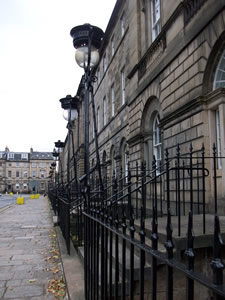 The Georgian House is a refurbished Georgian townhouse standing unobtrusively among the other buildings ringing Charlotte Square. Its interior appears as it would have in 1796, and recounts the era when a newly gentrified and well-educated Edinburgh was nicknamed the “Athens of the North.” The house has been furnished and repainted in its original 18th century colors, which provide a memorable introduction to the elegance of wealthy New Town life. The dining room table is arranged with Sheffield plate, Wedgwood china and mid-18th-century glasses, while the chairs are mainly Edinburgh “brander backs”. The formal drawing room is in stately contrast to the intimacy of the parlor with its Staffordshire and Spode china services. A volunteer guide in each of the five rooms shares stories and trivia—from the kitchen in the basement to the fully stocked medicine cabinet in the bedroom. The Georgian House is a refurbished Georgian townhouse standing unobtrusively among the other buildings ringing Charlotte Square. Its interior appears as it would have in 1796, and recounts the era when a newly gentrified and well-educated Edinburgh was nicknamed the “Athens of the North.” The house has been furnished and repainted in its original 18th century colors, which provide a memorable introduction to the elegance of wealthy New Town life. The dining room table is arranged with Sheffield plate, Wedgwood china and mid-18th-century glasses, while the chairs are mainly Edinburgh “brander backs”. The formal drawing room is in stately contrast to the intimacy of the parlor with its Staffordshire and Spode china services. A volunteer guide in each of the five rooms shares stories and trivia—from the kitchen in the basement to the fully stocked medicine cabinet in the bedroom.
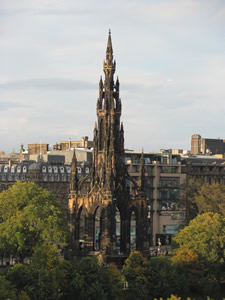 Princes Street Gardens stretch along the grassy base of the craggy rock holding up Edinburgh Castle. Once a large lake, the Nor’Loch, which was drained around 1800 as part of the Georgian expansion of Edinburgh, for years the park was the private domain of wealthy locals until it was opened to the public around 1870. Further along Princes Street, stands the Sir Walter Scott Monument. Built in 1840, this elaborate Neo-Gothic monument honors the great author, one of Edinburgh’s many illustrious sons. When Scott died in 1832, it was said, “Scotland never owed so much to one man.” Princes Street Gardens stretch along the grassy base of the craggy rock holding up Edinburgh Castle. Once a large lake, the Nor’Loch, which was drained around 1800 as part of the Georgian expansion of Edinburgh, for years the park was the private domain of wealthy locals until it was opened to the public around 1870. Further along Princes Street, stands the Sir Walter Scott Monument. Built in 1840, this elaborate Neo-Gothic monument honors the great author, one of Edinburgh’s many illustrious sons. When Scott died in 1832, it was said, “Scotland never owed so much to one man.”
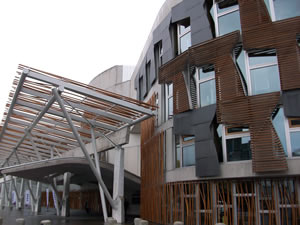 Returning to old town, we stepped through security into the newly completed modern Scottish Parliament Building. Scotland’s parliament originated in 1293 and was dissolved by England in 1707. In 1998, it was decided that the Scottish Parliament would return to Edinburgh, and in 1999, it was formally reopened by Queen Elizabeth. “Except for matters of defense, foreign policy, and taxation, Scotland now enjoys home rule. In 2004, the Parliament moved into its striking new home. The eco-friendly building, by Catalan architect, Enric Miralles, mixes wild angles, lots of light, bold windows, oak, and local stone into a startling complex that would, as he envisioned, “arise from the sloping base of Arthur’s Seat and arrive into the city as if almost surging out of the rock.” My husband particularly enjoyed viewing this very modern seat of government. Returning to old town, we stepped through security into the newly completed modern Scottish Parliament Building. Scotland’s parliament originated in 1293 and was dissolved by England in 1707. In 1998, it was decided that the Scottish Parliament would return to Edinburgh, and in 1999, it was formally reopened by Queen Elizabeth. “Except for matters of defense, foreign policy, and taxation, Scotland now enjoys home rule. In 2004, the Parliament moved into its striking new home. The eco-friendly building, by Catalan architect, Enric Miralles, mixes wild angles, lots of light, bold windows, oak, and local stone into a startling complex that would, as he envisioned, “arise from the sloping base of Arthur’s Seat and arrive into the city as if almost surging out of the rock.” My husband particularly enjoyed viewing this very modern seat of government.
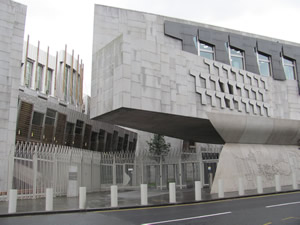 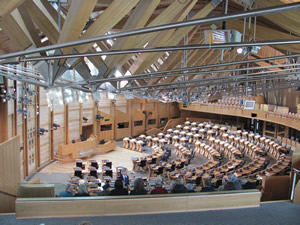
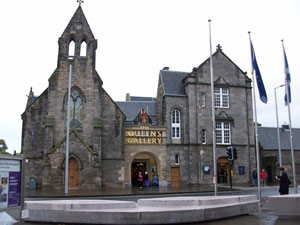 The Queens Gallery stands across the street, and we toured the art exhibit there before entering the Palace of Holyroodhouse. “ An abbey—part of a 12th century Augustinian monastery—originally stood in its place. It was named for a piece of the cross brought here as a relic by Queen (and later Saint) Margaret. Because Scotland’s royalty preferred living at Holyroodhouse to the blustery castle on the rock, the palace evolved over time. The building, rich in history and décor, is filled with elegantly furnished rooms and a few darker, older rooms with glass cases of historic bits and Scottish pieces that locals find fascinating. Throughout the clan battles for independence from England, this palace served as a pawn between opposing forces. In its changing fortunes, it has housed a strange assortment of monarchs involved in traumatic events: Mary Queen of Scots, Bonnie Prince Charlie, James VII (before his ascendancy to the throne), and French King Charles X (on his forced abdication after an 1830 revolution). The building's present form dates from the late 1600s, when it was rebuilt in a dignified neo-Palladian style. Today, Holyroodhouse is one of Queen Elizabeth's official residences.” The Queens Gallery stands across the street, and we toured the art exhibit there before entering the Palace of Holyroodhouse. “ An abbey—part of a 12th century Augustinian monastery—originally stood in its place. It was named for a piece of the cross brought here as a relic by Queen (and later Saint) Margaret. Because Scotland’s royalty preferred living at Holyroodhouse to the blustery castle on the rock, the palace evolved over time. The building, rich in history and décor, is filled with elegantly furnished rooms and a few darker, older rooms with glass cases of historic bits and Scottish pieces that locals find fascinating. Throughout the clan battles for independence from England, this palace served as a pawn between opposing forces. In its changing fortunes, it has housed a strange assortment of monarchs involved in traumatic events: Mary Queen of Scots, Bonnie Prince Charlie, James VII (before his ascendancy to the throne), and French King Charles X (on his forced abdication after an 1830 revolution). The building's present form dates from the late 1600s, when it was rebuilt in a dignified neo-Palladian style. Today, Holyroodhouse is one of Queen Elizabeth's official residences.”
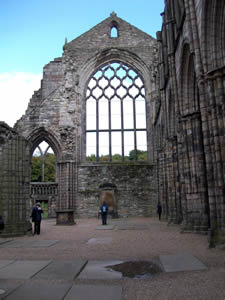 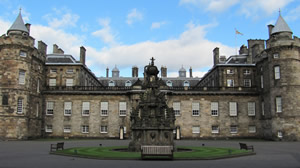
|